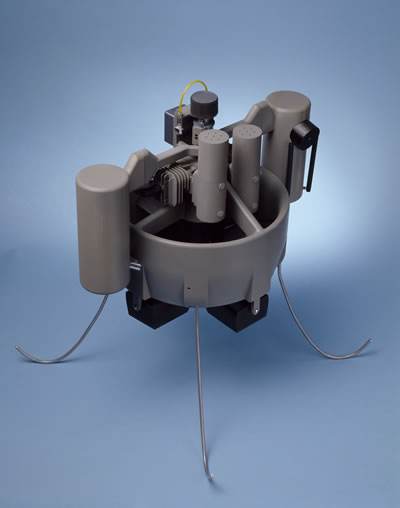 Honeywell is developing for the FCS program a backpack-sized Miniature Air Vehicle (MAV) designed to gather and transmit battlefield Information in support of small units operations. The development of the MAV was part of an Advanced Concept Technology Demonstration (ACTD) program developed for DARPA and has since transitioned into advanced development under the US Army Future Combat Systems’ program. Once matured, the micro air vehicle will become become the smallest unmanned aerial element of the U.S. Army’s Future Combat Systems program, providing “hover and stare” capability at the platoon level. Class I is one of four UAV systems organic to platoon, company, battalion and brigade echelons that form the aerial component of the FCS networked system-of-systems, providing protection and information to soldiers on the ground.
Honeywell is developing for the FCS program a backpack-sized Miniature Air Vehicle (MAV) designed to gather and transmit battlefield Information in support of small units operations. The development of the MAV was part of an Advanced Concept Technology Demonstration (ACTD) program developed for DARPA and has since transitioned into advanced development under the US Army Future Combat Systems’ program. Once matured, the micro air vehicle will become become the smallest unmanned aerial element of the U.S. Army’s Future Combat Systems program, providing “hover and stare” capability at the platoon level. Class I is one of four UAV systems organic to platoon, company, battalion and brigade echelons that form the aerial component of the FCS networked system-of-systems, providing protection and information to soldiers on the ground.
The MAV ACTD is designed as a ducted fan air vehicle, and flies like a helicopter, using a propeller that draws in air through a duct to provide lift. The MAV’s propeller is enclosed in the duct and is driven by a gasoline engine. A heavy fuel engine variant of the MAV will be available in 2006. The MAV is controlled using Honeywell’s micro-electrical mechanical systems (MEMS) electronic sensor technology.
The system consists of two air vehicles with support equipment of fuel, batteries, an observer/controller unit, remote video terminal and starter. Each vehicle weighs about 17 pounds fully fueled, is 13 inches in diameter and designed to be transported in a back pack. The vehicle operates at altitudes of 100 to 500 feet above ground level, and can provide forward and down-looking day or night video or still imagery. The vehicle will operate in a variety of
weather conditions including rain and moderate winds.
Soldiers can be trained on vehicle operation in less than 24 hours and then can immediately begin to operate the vehicle for proficiency training. Unlike other unmanned aerial systems, no specialized military training is needed to operate the MAV or exploit its data and imagery.
In October 2005, the Class I MAV was tested by the 25th Infantry Division soldiers, receiving positive reviews. During the tests, an infantry scout platoon used the hovering micro UAV to obtain reconnaissance information instead of sending out soldiers to conduct reconnaissance missions. Typical missions were flown to scout convoy driving routes, and collection of real-time information to improve situational awareness. MAV simplicity of operation was demonstrated in these tests – according to DARPA, soldiers who were familiar with commercial video games found it easy to learn to operate the MAV.
The user evaluation tests performed by the 25th ID concluded the program’s second development phase. In 2006 Honeywell will improve the system based on user feedback and deliver 25 additional, improved systems to the 25th Infantry Division beginning in July 2006 for five months of user evaluations. Among other improvements, these new systems will have increased vehicle endurance, improved sensor performance, and better observer/controller units.
On May 24, 2006 Boeing, the FCS program integrator awarded Honeywell a $61 million development contract to fully develop the Class I UAVS. First prototype deliveries and flight tests are scheduled for December 2008.

















